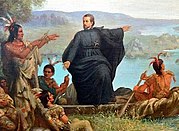- For the French alliances in the Indian subcontinent see Franco-Indian alliances.

Map showing the 1750 possessions of Britain (pink), France (blue), and Spain (orange) in contemporary Canada and the United States.
| Foreign alliances of France | |||||||||||||||||||||||||||||||||||||||||||||||||||||||
|---|---|---|---|---|---|---|---|---|---|---|---|---|---|---|---|---|---|---|---|---|---|---|---|---|---|---|---|---|---|---|---|---|---|---|---|---|---|---|---|---|---|---|---|---|---|---|---|---|---|---|---|---|---|---|---|
| |||||||||||||||||||||||||||||||||||||||||||||||||||||||
The Franco-Indian alliance was an alliance between American Indians and the French, centered on the Great Lakes and the Illinois country during the French and Indian War (1754–1763).[1] The alliance involved French settlers on the one side, and the Abenaki, Ottawa, Menominee, Winnebago, Mississauga, Illinois, Sioux, Huron-Petun, Potawatomi etc... on the other.[2] It allowed the French and the Indians to form a haven in the middle-Ohio valley before the open conflict between the European powers erupted.[3]

Father Jacques Marquette with Indians.

Frontenac with the Indians.
France had a long presence in Northern America, starting with the establishment of New France in 1534. Acculturation and conversion were promoted, especially through the activities of the Jesuit missions in North America. According to the 19th-century historian Francis Parkman:
"Spanish civilization crushed the Indian; English civilization scorned and neglected him; French civilization embraced and cherished him"
—Francis Parkman.[4]
French settlers moved southward to the Louisiana, along the Ohio and the Mississippi valleys. France allied with the majority of the First Nations in North American, with the intent of defeating the British. According to one observer:
"All the Indian nations were called together and invited to join and assist the French to repulse the British who came to drive them out of the land they were then in possession of."[5]

Conference between the French and Indian leaders around a ceremonial fire.
Montcalm trying to stop Native Americans from attacking British soldiers and civilians as they leave Fort William Henry.
French and Indian troops were combined in offensives against the British. In July 1757, Montcalm assembled a force of 6,000 regulars and 2,000 Indians in the Battle of Fort William Henry.
In 1759, as Britain had a string of successes, especially with the Battle of Fort Niagara, the French were unable to properly supply and support their Indian allies, and the Franco-Indian alliance started to unravel. At the same time, the British were making promises of support and protection to the Indians. Finally Quebec fell in September in the Battle of the Plains of Abraham.[6]
Long after the extinction of New France in 1763, Franco-Indian communities would persist, practicing the catholic faith, speaking French and using French names.[7] From the Saint Lawrence to the Mississippi, cosmopolitan French communities accommodated Indians and Blacks.[8]
During the American War of Independence and the onset of the Franco-American alliance, the French would again combine with Indian troops, as in the Battle of Kiekonga in 1780 under Augustin de La Balme.[9]
See also[]
- Foreign alliances of France
- French and Indian War
- Kahnawake surnames
Notes[]
- ↑ Family Life in Native America by James M. Volo, Dorothy Denneen Volo p.316 [1]
- ↑ Family Life in Native America by James M. Volo, Dorothy Denneen Volo p.316 [2]
- ↑ The American Revolution in Indian country by Colin G. Calloway p.6
- ↑ Quoted in Cave, p.42
- ↑ Quoted in Family Life in Native America by James M. Volo, Dorothy Denneen Volo p.316 [3]
- ↑ The scratch of a pen by Colin Gordon Calloway p.5
- ↑ The American Revolution in Indian country by Colin G. Calloway p.3
- ↑ The American Revolution in Indian country by Colin G. Calloway p.3
- ↑ The American Revolution in Indian country by Colin G. Calloway p.41 [4]
References[]
- Alfred A. Cave The French and Indian War 2004 Greenwood Press ISBN 0-313-32168-X
The original article can be found at Franco-Indian alliance and the edit history here.